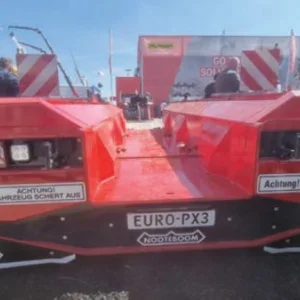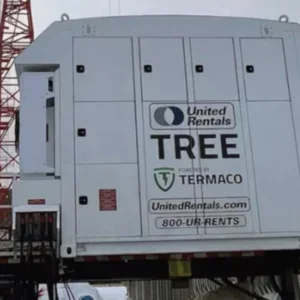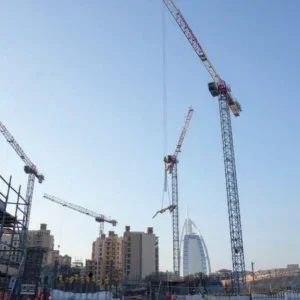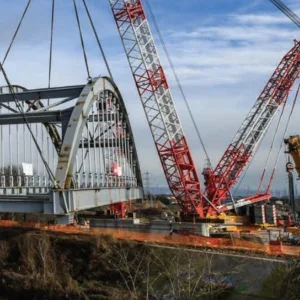Across the downs and valleys of Kent in the south east corner of England a long thin scar of freshly moved earth currently traces the route of the Channel Tunnel Rail Link (CTRL), the UK’s first high speed train line.
For a long time it seemed as though work would never start. Many years were spent searching for a route that upset as few people as possible, followed by wrangling over funding strategies.
The first phase, costing more than £2bn ($3.2bn), is more than 18 months into construction. Six big civil engineering contracts are in progress with earthmoving, piling, bridge concreting and track work. The sequence of structures and foundations demands continuous use of cranes, both for foundation work and for general lifting.
There are not as many heavy piling rigs in use as might be expected, because the £5.2bn ($8.3bn) project was split into two phases just before work started. Much of the more complicated tunnels and cuttings work, with its heavy diaphragm walling or secant piling, is still to come.
“That is when we shall get the payback on some of the equipment we bought before 1998,” says Phil Ritchie, rental division manager for AGD, the European agent for the Japanese IHI cranes and one of a number of hire firms with an interest in the project. AGD modernised many of its rigs several years ago with all hydraulic models including four 70t DCH 700s and seven DCH 800s, in anticipation largely of the CTRL work.
Prior to 1998, contracts for the whole line were expected to be let simultaneously, but the work was re-phased to spread the financial burden on the public purse. This means that work, and plant use, is less intense, Ritchie says, though he concedes that with six cranes working, the firm has “had a fair share”.
But the first 74km section of the route crosses Kent countryside, hugging existing railway and motorway corridors as far as possible, to minimise the environmental impact. The second 35km section runs from Dartford in north Kent, under the river Thames east of London, and into the heart of the capital, mainly in tunnels and cuttings.
In north Kent, just south of the Thames, joint venture contractors Alfred McAlpine and Amec are moving three million cubic metres of earth. But as well as muckshifting and track bed forming there are a number of major structures to be built. As well as about 20 smaller bridges there are larger crossings for a new highway interchange. Amec Piling has used its own rigs for piling work, using a 50t-rated IHI CCH 500-3II and an 80t NCK 1405; altogether there are some 15 cranes on site. A telescopic boomed CCH 300T has also found particular use; the 30t crane has retractable crawler tracks that give it a narrower base and allow easier access to narrow spaces. Old mechanical machines are much in evidence throughout the project. Among other cranes on Amec-McAlpine’s contract are an American 5299, a 50t NCK Atlas, a Priestman 250 and an NCK C41.
“We also hire in telescopics for particular lifts, mainly from Baldwins,” says plant manager Colin Hale. “Those are used on a day basis as needed and we have had an 80t Liebherr AT here quite lot, and a bigger Liebherr 100t AT. A larger 400t lift was used to place bridge beams at one point.” Moving away from London, the next contract along is the spectacular crossing over the river Medway, where the new railway will run alongside both the original M2 motorway as well as a new bridge being constructed to widen it. The new road bridge will fit between the old road bridge and the new CTRL crossing, which means “we could have some competition for tower crane airspace later,” says Martin Feeney of Miller Civil Engineering. Miller is in the Eurolink joint venture with Dumez/GTM of France and Beton & Monierbau of Austria, building the £30m rail bridge and the subsequent tunnel through the hills of the North Downs, under a separate £80m contract.
The 1,280m-long bridge over the river is perhaps the most spectacular site on the route. Four big Liebherr 280/290 tower cranes are now sitting across the valley where the bridge piers are already waiting for their deck.
On the river’s west bank the London-Rochester rail line runs along the valley edge, crossing the site at right angles. To avoid any danger here the closest of the cranes is fitted with SMIE electronic limiters which prevent the crane slewing into space over the railway by automatic cut-outs and braking.
Construction has begun on the concrete deck which will sit on 24 piers across the river. It is being built both by a balanced cantilever method from the main centre piers and also by jacking of two sections, one from each side.
“Earlier on we had a number of piling rigs here,” says Feeney, “an Andes C41, a Casagrande C90 and an NCK Ajax C75 all used by [piling subcontractor] Bachey-Soletanche. A Ruston-Bucyrus 1100 set the casings.” Miller itself also used an IHI CCH500 for formwork movement “hired from our own plant section”.
Feeney says: “For telescopics we have a contract with Ainscough as preferred supplier and they have sent in various cranes up to 400t in size for different lifts.” Ainscough is also preferred supplier for Hochtief/Norwest Holst’s £85m contract next along, which involves various bridges, including four crossings on the critical path and some piling. Much more equipment has been needed for Kvaerner’s £150m section where the line, much of it in tunnel, passes through the town of Ashford and its international railway station. There is also a 1.5km section to the north of the town where the line is on a viaduct on piers at 16m spacings.
Plant manager Alan Day says that for the 4,000 piles here, several rigs are being used including two newly-bought BG30s from Bauer using Sennebogen base machines, two Cemdrills sitting on a 38 RB and a 51/60 NCK, and some Soilmec rigs. “Most are purpose built,” he says.
These rigs need big cranes to work with them. “We make up the reinforcement cages in the yard and bring them over. They are more than 30m long and weigh up to 14t so you need a hefty crane.” Kvaerner has 50t, 70t and 80t machines “all hired in”, including Sumitomos, IHIs and NCKs.
Day uses a variety of hire firms as suppliers, including Initial GWS, Eagle Cranes, Birse Plant Hire and AGD. Price paid depends on the market at the time, he says, though there is not much price difference between the rental companies.
Two cranes work Kvaerner’s yard and there is one with each piling rig. Day says that the cranes used are mainly hydraulic because they are faster on the ground; the older mechanicals cannot get about so fast. For handling cages and moving tremmie pipes in for the concreting, done under bentonite, the cranes need to be quick, he says.
Kvaerner does have some of its own old mechanical crawlers on the project. “They are more static and tend to get used for the building work side.” On top of that there are mobile telescopics coming in on an occasional basis from Hewden Crane Hire.
Once the intensive foundation work is over, crane use will wind down in the Ashford area, apart from some building works. But on the final contract, Balfour Beatty Major Projects’ 16km section south of Ashford to the Channel Tunnel entrance, equally intensive foundation work will be followed by some interesting lifts.
This £75m contract involves constructing the new line alongside, and sometimes above and around, the existing main line from Ashford to the Chunnel. Cut and cover sections, bridges and a high viaduct are all needed to carry the line up and around the existing path. Like elsewhere, cranage to date has focused on foundations, with piling rigs and support cranes. “They are fairly lightweight,” says project manager Andrew McNaughton, “mainly 50t, not larger.” For structures and lifting in precast concrete elements, mostly mobiles are used, usually around the 50t capacity range. Ainscough’s Dover depot has a tie-in for this contract.
McNaughton says he is thinking of bringing in 200t Manitowoc 4100 crawlers for installing composite pre-cast lid sections for a cut and cover tunnel and, elsewhere, to lift in a steel viaduct. Because of an agreed design change this 350m-long structure, in the complex area just outside the Chunnel terminal, is now lower than its original 20m and cranes could prove cheaper than the originally envisaged incremental launch. Some lifts are even bigger. Ainscough is deploying its new 650t Demag AC 2000 shortly to lift out a redundant footbridge.
Future lifts being planned for the coming months may see a rail bridge being placed by a pair of 1,000 tonners in tandem. “We have not decided yet and the site is very difficult,” says McNaughton. “It is a cramped site and there is almost no space for the cranes in between the existing line and the road access.” When the first phase finishes in 2003 the UK will have its first full superfast train service to the eastern edges of London, from where the trains will switch back to existing track to Waterloo station in south London. Major work on the second phase starts next year. Only when that is finished in 2007, complete with new international stations in north Kent, east London, and St Pancras in central London, will the full benefits of the project be realised: Paris will be two hours 20 minutes from London, a time saving of just 34 minutes, but enough perhaps to persuade people to go by train rather than fly.






